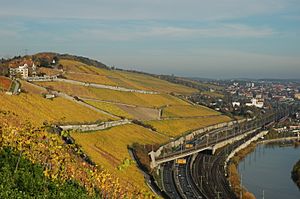Würzburger Stein facts for kids
Lua error in Module:Location_map at line 420: attempt to index field 'wikibase' (a nil value). Würzburger Stein is a very old and famous vineyard in Franconia, a wine region in Germany. It has been making a special kind of wine called Steinwein for a very long time, possibly since the 700s! This vineyard is on a hill overlooking the Main river, near the city of Würzburg.
Würzburger Stein is one of Germany's oldest places for making wine. It is also one of the biggest single vineyards in Germany, covering about 85 hectares (which is like 210 football fields). Today, the main grapes grown here are Riesling and Silvaner.
Contents
History of Würzburger Stein
People have been growing grapes at Würzburger Stein since at least the year 779. This makes it one of the oldest vineyards in Germany. It's even thought that an Irish missionary named Saint Kilian helped spread wine growing in the Franconia area in the 600s. He is now seen as the special saint for wine growers there.
Records from 1665 show that a monk from the Cistercian order planted the first Silvaner grapevines here. This was one of the first times this grape was planted in Germany.
Over time, wine making at Würzburger Stein, and in most of Franconia, slowed down. This happened between the 1500s and 1800s because of many wars, plant diseases, and people starting to drink more tea and coffee.
Throughout history, the Steinwein from this vineyard has been mentioned in many books and writings. A famous German poet, Johann Wolfgang von Goethe, said this wine was one of his favorites. He wrote many lines praising how good it was!
In the 1840s, a French wine writer named André Jullien visited the vineyard. He wrote that the sweet Steinwein was very strong. He also noted that the grapes were dried on mats after being picked, before they were turned into wine. This method made the wine sweeter and stronger, similar to what are called "straw wines."
The 1540 Vintage Wine
Records from the past show that the year 1540 was very hot in Germany. Some reports say there was a long drought, and it was so hot that the Rhine river even dried up! People could walk across the riverbed. This heat helped the grapes grow very well, and they became super ripe. Some vines even produced a second harvest later in the year.
It was a tradition in German wine regions to celebrate special years by filling large wooden barrels with wine. A barrel of Steinwein from the 1540 vintage was kept by the Prince-Bishop of Würzburg. To keep the wine fresh, it was regularly "topped up" with newer wine of similar quality. This stopped air from getting in and spoiling the wine.
The wine was then put into bottles in the late 1600s. Some of these bottles were kept in the cellar of King Ludwig I of Bavaria. Later, in the 1900s, they ended up with a wine seller in London.
In 1961, a bottle from this 1540 vintage was tasted by several wine experts in London. One of them was the famous wine writer Hugh Johnson. The wine was 421 years old at the time, making it one of the oldest wines ever tasted!
In his book, Vintage: The Story of Wine, Hugh Johnson said the Steinwein looked like Madeira wine, with a deep brown color. He described it as almost like a "living thing" because it had survived for so long. He also said it still showed the special qualities of the German vineyard. However, he noted that the wine quickly turned to vinegar after the bottle was opened.
Today, an unopened bottle from the 1540 vintage is still kept in the cellars of the Bürgerspital zum Heiligen Geist wine estate in Würzburg.
Was it the "Oldest Wine" Ever Tasted?
Even though the 1540 wine was very old, some experts question if it was truly the "oldest wine ever tasted." This is because it was topped up with newer wine for over a hundred years. This means it was a mix of different years, a bit like a "solera" style wine.
Other wines have also been considered for the title of "oldest wine ever tasted." For example, a 1646 bottle of Tokay wine was tasted by Australian wine expert James Halliday in the 1970s. That wine was over 324 years old.
The Vineyard Itself
The German word "stein" means "stone." This refers to the rocky limestone soil of the vineyard. It is located on a hillside outside Würzburg, looking over the Main river.
The hill has a curved shape and a steep slope. This gives the grapevines perfect sunlight. The nearby river also helps keep the temperature steady. These conditions help the grapes ripen fully while keeping the right amount of sourness (acidity) to balance their sweetness. This is a big help in the continental climate of Franconia, which can often have frost.
Grapes and Wines from Würzburger Stein
The two main grapes grown at Würzburger Stein are Riesling and Silvaner. This vineyard is one of the warmest spots in Franconia. Because of this, it's one of the few places in the region where Riesling grows very well.
The Riesling wines from Würzburger Stein are known for their "piquant" (lively) sourness. This balances the fruity taste of the grape. These wines also tend to have a long-lasting taste after you drink them. The Silvaner wines from this vineyard are usually full-bodied and have a strong, pleasant smell.





